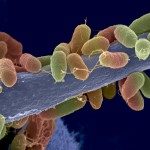Link to Pubmed [PMID] – 15321679
FEMS Microbiol. Lett. 2004 Aug;237(2):317-24
Aspergillus fumigatus is an opportunistic pathogenic fungus which causes fatal invasive aspergillosis among immunocompromised patients. To obtain a better understanding of the key elements involved in A. fumigatus virulence and to identify possible drug targets, it is necessary to be able to generate gene-deletion strains. Unfortunately, the molecular techniques available do not include a rapid method to disrupt and identify essential genes. RNA interference, a process in which the presence of double-stranded RNA homologous to a gene of interest results in specific degradation of the corresponding message, has been successfully tested on A. fumigatus. We have shown that expression of double stranded RNA corresponding to portions of the ALB1/PKSP and FKS1 genes results in reduced mRNA levels for those genes, with phenotypic consequences similar to that of gene disruption. The two genes could also be subjected to simultaneous interference through expression of chimeric double-stranded RNA. Use of RNA interference in Aspergillus will allow easier examination of the phenotypic consequences of reducing expression of a gene of interest, especially for essential genes.



